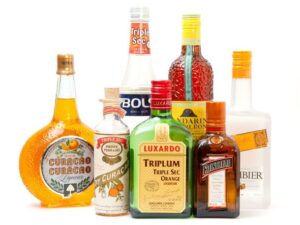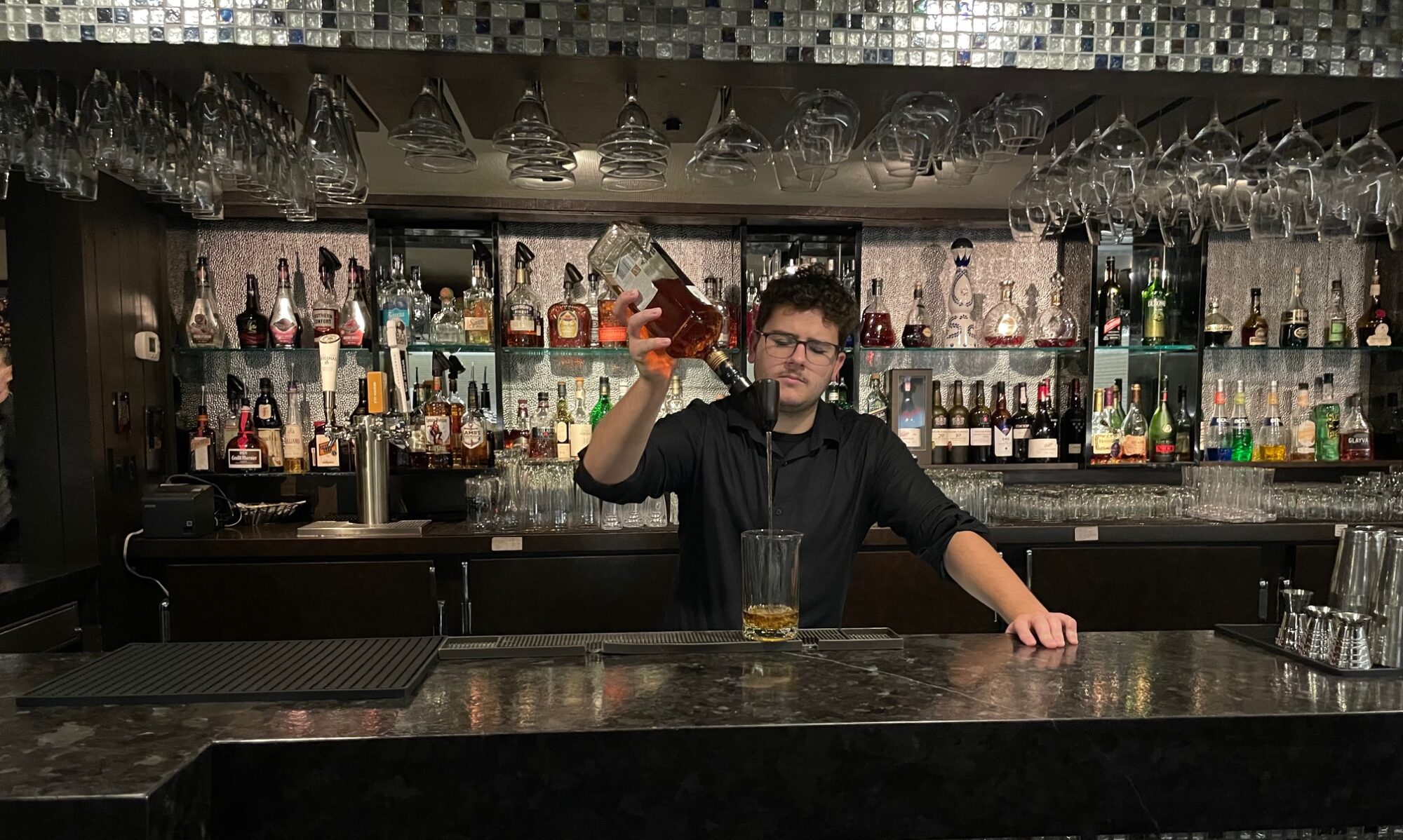When talking about different “hard liquor”, there are two terms we use often behind the bar. These are spirits and liqueurs. From my experience in the job, I’ve come to know spirits as your basic liquors. Your vodka, rum, whiskey, gin, tequila, etc. These all tend to be stronger, without much for added flavors. Liqueurs, on the other hand, seem to be more of your flavored liquors, like peach schnapps, cherry whiskey, blue curacao, crème de menthe, etc. My plan today is to find out if my assumptions are correct, and if there are actual definitions to differentiate liqueurs and spirits. Basically, I’m trying to find out at what point a bottle of alcohol becomes a liqueur rather than a spirit.
 Image Taken from bloomberg.com
Image Taken from bloomberg.com
Spirits is another word for liquors. All alcohol, in one way or another, comes from distilling a fermented beverage. Distillation is a way of removing the water from a fermented beverage in order to produce a concentrated alcohol. This is how we make all of our alcohol, from beer to wine to our spirits. There are 6 “base” spirits, each coming from different fermented beverages being distilled. These are:
Vodka – a neutral spirit, made to be flavorless and odorless liquor. It is often distilled from various grains, and in some cases potato’s, molasses, or sugar beets. Vodka, being flavorless by design, mixes well into many cocktails and beverages.
Tequila – a spirit distilled from blue agave, which is reflected in its agave flavor. A high quality tequila will state its 100% blue agave status on the label. There are 5 different kinds of tequila, mostly reflecting the aging of the tequila rather than a difference in how they are made. Except for one, the Mezcal tequila, which has a much different process than the regular tequila including having a worm in the bottle.
Gin – a very aromatic and pungent spirit, distilled with a variety of botanicals. However, to qualify as gin it must include juniper. Gin comes in many styles with varying tastes, simply because there are so many different ingredients that can be used to distil it. Its a delicate liquor with delicate balances of flavors.
Whisky – another spirit distilled from grains. The big difference here between whisky’s and grain-distilled vodka, is that whisky is aged in wood barrels straight from distillation. The brown color of whisky comes from the wooden barrels they are aged in. The thing about whisky is that there are many different kinds. Rye, Scotch, Bourbon, ect, each with their own flavors, even if some are only slightly different from others.
Rum – a spirit distilled from sugarcane products, like molasses. They can be made with a variety of flavors, such as a tamer light rums, brown spiced rums, and dark rums. Rums originated in tropical islands such as the Caribbean’s, which is they are often used in “tropical” themed drinks like mai tais and Pina coladas. High proof rums are also often used in cocktails to be lit on fire, adding some flair to certain cocktails
Brandy – a fine spirit distilled from grapes or fruits. This is commonly seen as one of the finest spirits. There are a few kinds of brandy, such as Cognac and Armagnac, each named for the region of France they are distilled in. Being distilled from fruit allows many different flavors and types. Brandy is a liquor I’ve noticed is not often mixed with anything else. Its usually saved to be sipped and enjoyed. The few cocktails I’ve made with brandy seem to be quite “classy” cocktails, such as the Champaign cocktail which is just brandy, Champaign, and a sugar cube with a few drops of bitters.
In most cocktails, we use one of these 6 spirits as a “base” for the drink, the main ingredient that we build the rest of the drink around.

Liqueurs, on the other hand, are much more broad. They are made from a spirit, with some sort of added ingredient acting as a sweetener. There are way too many to try and list them all. Somewhere out there, there is a liqueur for any flavor you could want. The difference between a spirit and a liquor come from the sweetener, whether its to get the cherry flavor in cherry whisky or the coffee flavor in Kahlua. Both give very different flavors, but are very sugary regardless. Another thing to note with liqueurs is that they typically have a lower alcohol percentage, around 24-30%. This has acceptations of course, with some reaching as high as 60% alcohol.
In the workplace, we rarely use liqueurs as a base. Instead, we use them as what’s called a modifier, basically a secondary ingredient to add a flavor of the drink. Not all modifiers are liqueurs, some sources call lemon or lime juices, syrups, and even egg whites modifiers as well. We also use mixers in some cocktails, which is basically your juices (think orange juice, clamato, or cranberry juice) or pop, tonic, and other non alcoholic beverages. Your mixer will typically make up the bulk of your drink, while the modifiers add flavors and texture, while spirits make the base. Its important to note that not all cocktails use a base, modifier, and mixer all at once. Some cocktails will use a liqueur as a base rather than a spirit. This is all to say that the definitions of base, modifier, and mixer, are quite fluid depending on the cocktail being made. I hope to go more in depth with this by talking about specific recipes.
Writing this post, I was surprised to find that there were 6 clear agreed on spirits. Some debate on whether a liquor like absinth is a spirit or not, but everyone agrees on these 6. I found the book I have, “The Ultimate Bar Book” by Mittie Hellmich has a great guide to each of these spirits, as well as general guides to liqueurs as a whole as well as beer and wine. It doesn’t just detail the process of creation, but the history behind them and the different kinds of each. I hope to go into more detail about some of this information in future posts.
For more information on the 6 main spirits, check out this video by the Tipsy Bartender, I found it really helpful making this post.
Thanks for reading!

Wow, what an amazing blog post. I am amazed on how far in depth you went and I thoroughly enjoyed reading. So much information behind alcohol and what goes best with different kinds. How long have you been in the job??
I have seen the tipsy bartender content online and he is such a funny guy, great way to finish up the post!
Charlie, I really liked your blog’s appearance, it looks so professional! I liked how you described each liquor but I think it may be too much for a reader. I liked that you added a video to summarize all the previous information.
I find it humorous that, as a very Christian person, I found this post and was so invested in it. I have never needed this knowledge, and I doubt I ever will, but it was super interesting nonetheless. Keep up the learning!
Bernice
Hey Charlie! Wow! you are really taking this mixology project to a very academic level, I learned a lot through reading your post. One thing about Tequila I would like to add, I’m not sure if you know, but if it is not made in Mexico you legally cannot call it Tequila which I thought was pretty fascinating. I see you found Tipsy Bartender! I love his tik toks and before I started bartending I watched his youtube videos, probably many of the ones you have watched. I find his tiktoks of making the massive punchbowls wiith ridiculous amounts of alcohol so entertaining.
Wow! This was such an informative post! I’ve always wondered what were the pillars of cocktails and now I know. I also loved that you embedded the Tipsy Bartender video. I used to watch his videos a long time ago because I loved the beautiful drinks, but his personality is so enthusiastic.